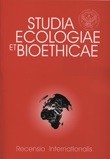The impact of roosting birds on the abundance of two groups of soil mesofauna
The impact of roosting birds on the abundance of two groups of soil mesofauna
Author(s): Krassimira Ilieva-Makulec, Dawid Kozacki, Grzegorz MakulecSubject(s): Essay|Book Review |Scientific Life
Published by: Wydawnictwo Naukowe Uniwersytetu Kardynała Stefana Wyszyńskiego w Warszawie
Keywords: corvids; roost; enrichment; mites; springtails
Summary/Abstract: The aim of the study was to assess the influence of corvid urban roosts on the abundance of two groups of soil mesofauna: mites and springtails. Two areas located in the city of Warsaw were taken into consideration, one subjected to winter roosting activity of corvids and the other not influenced by birds. The samples were taken three times, in May, July, and September of 2013. The results show a positive effect of corvid roosts on the density of soil mesofauna, especially in the top 0–5 cm soil layer. On each sampling date, we found more numerous communities of mites and springtails in the soil within the roosting area than in control. The average densities of mites ranged from 30×103 ind. m–2 to 200×103 ind. m–2 in the soil within the roost and from 6 ×103 ind. m–2 to 40×103 ind. m–2 in the control. In the case of springtails the average densities ranged from 9×103 ind. m–2 to 36×103 ind. m–2 in the roost and from 4×103 ind. m–2 to 8×103 ind. m–2 in the control. Among the two groups, mites prevailed over the springtails both in the soil of roost and control area. We inferred that the corvid roosting activity, involving mainly an excrement deposition on the soil surface, influences soil mesofauna indirectly through many related changes occurring in soil environment e.g. in nutrient availability, soil acidity, microbial communities.
Journal: Studia Ecologiae et Bioethicae
- Issue Year: 13/2015
- Issue No: 4
- Page Range: 117-133
- Page Count: 17
- Language: English

